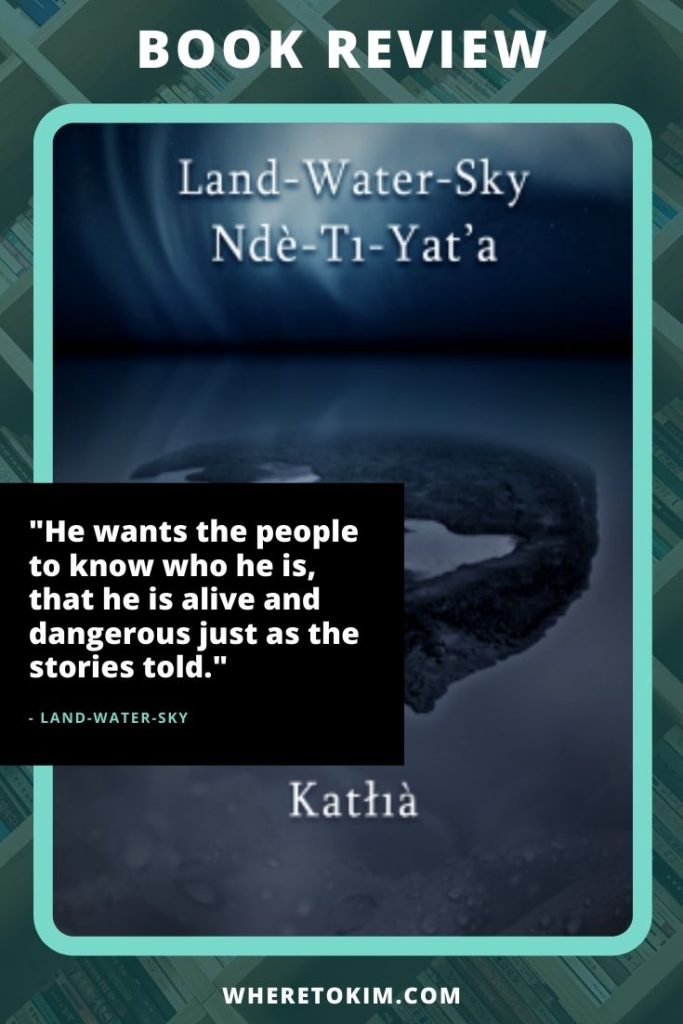Land-Water-Sky by Katłıà is a mythical story collection inspired by Dene (Canada) legends and myths. What if the otherworldly lived among us?
Land-Water-Sky / Ndè-Tı-Yat’a synopsis
A vexatious shapeshifter walks among humans. Shadowy beasts skulk at the edges of the woods. A ghostly apparition haunts a lonely stretch of highway. Spirits and legends rise and join together to protect the north.
Land-Water-Sky/Ndè-Tı-Yat’a is the debut novel from Dene author Katłıà. Set in Canada’s far north, this layered composite novel traverses space and time, from a community being stalked by a dark presence, a group of teenagers out for a dangerous joyride, to an archeological site on a mysterious island that holds a powerful secret.
Riveting, subtle, and unforgettable, Katłıà gives us a unique perspective into what the world might look like today if Indigenous legends walked amongst us, disguised as humans, and ensures that the spiritual significance and teachings behind the stories of Indigenous legends are respected and honored.
Book review
The Medicine Man knows many stories of the land, water, and sky; legends that had existed from time immemorial.
The first two stories in Land-Water-Sky bring you back to medieval times. The writing style makes you feel like you’re reading a medieval manuscript in translation. Tales like Beowulf and Beauty and the Beast come to mind. But in this case, the Dene author Katłıà took her inspiration from the legends and myths of the Dene, an indigenous group living in the northern boreal and Arctic regions of Canada.
The stories are set around Yellowknife (Coppertown in the book) with the fictional Nàejì Island resembling Nishi Island / Old Fort Rae. The names of the characters in the book are spelled in the Weledeh-Tłįchǫ language. Very real, but also somewhat hard to read, and you’ll probably resort to just reading the first letter of the names.
One of the reasons Katłıà wrote this book is to start discussions about violence in familial relationships. This is visible in the beauty and the (shapeshifter) beast story at the start, but also in the story of Lafì set in modern times. Half of the characters are kind and good, while their counterparts are beasts in disguise (both otherworldly and human). The stories show the harshness of unequal fights: men and women fighting against and alongside otherworldly creatures. If you bring it down to the essence, it can be about any unequal conflict between humans as well.
I liked the first two stories the most because of the writing style. The more wordy, medieval-folk-tale-like writing style Katłıà used helped the immersion. This is where her strength lies. I was less fond of the writing style in the other stories. Then, after a forgettable intermezzo introducing Louie and the ghost on the road, the longer story of Deèyeh followed to link the past to the present, explaining it all, except for what I wanted to know about her past.
It feels like Katłıà missed a chance here. If she had continued that story, instead of switching to Lafì to tell the other side of the story, Land-Water-Sky would have been a better book. I wanted to read more about Deèyeh and her friend. It would have been so nice if the author had finished the book from their point of view.
Conclusion
After a mesmerizing start, Land-Water-Sky almost ended up an unexpected gem if not for the second part of the book. Still, I was surprised by how much I enjoyed reading the stories, finishing the book in one sitting. The setting, the Northwest Territories in Canada, is also very original. Do pick up this book if you like stories based on mythology and legends from a culture many of us don’t know much about. These stories certainly make me want to visit the northern part of Canada as they show the beauty of nature.
Interested?
Pre-order your copy of Land-Water-Sky from Amazon or directly from the publisher Fernwood Publishing (available 15 October 2020).
Many thanks to Fernwood Publishing and NetGalley for a digital ARC of this novel in exchange for an honest review.







